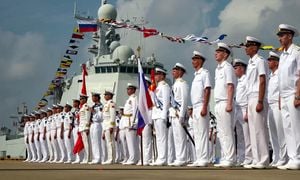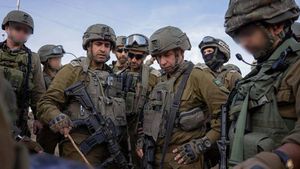The pace of global military tensions is reaching new heights, and the nuclear arms race is no exception. Recent events highlight the growing concern among world leaders about the nature and size of nuclear arsenals, which some believe are nearing dangerous levels.
To kick things off, let’s look at China. Shen Jian, the Chinese ambassador for disarmament, recently spoke at the United Nations General Assembly, stating unequivocally, "China has not, and will not, engage in a nuclear arms race." His comments were directed at the United States, which Shen accused of misrepresenting China's nuclear policy. He argued this misrepresentation fed the narrative supporting U.S. military power and preemptive nuclear strike strategies.
Shen reinforced China's long-standing no-first-use policy, emphasizing, "This is the most meaningful form of transparency." For China, ensuring the survivability of its limited nuclear forces remains priority number one, especially as it perceives global threats are shifting and becoming more complex, particularly from nations developing missile defense systems. Despite these advancements, China's disarmament commitments appear to hold firm, as reiterated by Shen’s call for all nuclear-armed states to negotiate a No First Use Treaty.
The U.S. has countered these assertions, with American officials claiming China has not fully disclosed its nuclear modernization efforts. Concurrently, President Biden's administration is re-evaluing its nuclear strategy amid growing concerns. Recent reports indicate the U.S. might allocate up to $1.7 trillion to modernize its arsenal over the next three decades, igniting fears of another arms race.
But the U.S. does not stand alone; other nations are making strides down this path as well. North Korea continues to develop its arsenal, evidenced by its recent missile tests. This paints the picture of the Korean Peninsula as yet another potential flashpoint. Experts assert the dangers of nuclear weapons have escalated since the Russian invasion of Ukraine brought new threats of atomic warfare back to the forefront.
Historically, this wave of nuclear concern is not unprecedented. After the Cold War, there was significant progress toward disarmament. Yet, with the collapse of key arms control treaties, including the New START Treaty, which caps the number of deployed nuclear warheads, the promise of reduced nuclear threats seems like a distant memory.
Interestingly, recent geopolitical efforts suggest the world may be rekindling its nuclear ambitions. For example, Iranian leaders are reportedly closer to developing usable nuclear weapons, raising fears of a regional arms race. Notably, the chaos brought on by Ukraine's conflict has prompted countries like Saudi Arabia to hint at potential nuclear development if Iran goes forward with its weapons.
Against this background, one must also address America's relationship with Taiwan. Tensions have risen as the U.S. has increased military support for Taiwan, leading China to issue stern warnings. The situation reflects the broader strategy of the U.S., which appears focused on encircling and countering Chinese influence through alliances and military preparedness.
Digging even more deeply, some analysts suggest the actions of the U.S. might be reminiscent of Cold War tactics. Is it possible the U.S. aims to draw China and Russia, both nuclear powers, back to the negotiating table through continued military posturing? With missile deployments to the Philippines and military drills nearby, the memories of the Cuban missile crisis linger. Back then, the Soviet Union planned to deploy missiles capable of threats against the U.S.—a scenario reminiscent of today’s geopolitical chess game.
Could we see history repeating itself? The U.S. is maneuvering through complex strategic waters reminiscent of the Cold War, but how will China and Russia respond? Will Beijing react similarly to how the Soviet Union did back then: by showcasing its military capabilities? Or will there be more diplomatic routes explored? Only time will tell, but the stakes are higher than ever.
We find ourselves at the intersection of alarm and hope, where rekindled conflicts may lead to dangerous outcomes, but also where opportunities for dialogue may open unforeseen doors. The future is unwritten, but one thing is certain—global dynamics are shifting, and the nuclear arms race remains central to international relations.
Negotiations are key, and nations must tread carefully as they navigate these treacherous waters. From the looks of things, we might be at the edge of another arms race or, perhaps, the dawn of renewed diplomatic engagement. The world is watching and waiting to see how these dynamics will play out before any irreversible paths are taken.



